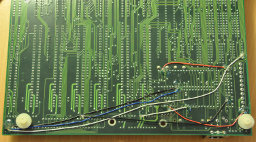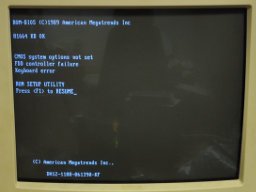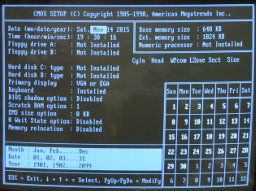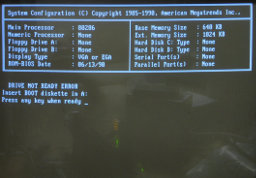First post, by Malvineous
- Rank
- Oldbie
Hi all,
For anyone who's interested, I've just had some success repairing an old Headland HT12/A 286 motherboard which suffered from a barrel battery leak many years ago.
As it turns out, the only problem was that a few of the PCB traces had been eaten away. After cleaning off as much corrosion as I could, I could see the gaps in the tracks:
I tinned all the traces and soldered some wire directly onto the PCB traces that were carrying power. The small signal traces were unfortunately too small to solder anything to, and were too thin for a conductive pen to work (I tried using sticky tape to mask off the area and successfully got a line drawn of the correct size, but there wasn't enough conductive fluid to make a low-resistance connection.) Applying power got a POST card to show 01 but that was it - no beeps, nothing.
In the end I realised why am I trying to redraw the PCB tracks, when I could just find where they go and bridge either end with some wire. Not the neatest solution but certainly the easiest. This didn't work initially - the POST card got from 01 to 03, but still no beeps. I had to desolder and remove the keyboard connector to discover that a couple of the tracks changed direction underneath it - sneaky! That discovery involved moving one of the wires and adding a new one.
Powering the board now gave me sound! Two high-pitched beeps followed by eight lower-pitched ones, and then an odd series of clicks. The post card then settled on 74. Looking up code 74 told me "Display SETUP prompt" which then made me realise the odd series of clicks would have been the memory test running! Looking up the beep codes, two beeps is a memory parity error and eight beeps is a video card error. As I was using unknown memory, it could well be bad. But I grabbed an ISA VGA card to see if I could get a picture, and all the beeps went away! So I'm not sure what the significance of the two high-pitched beeps is.
Since this motherboard was originally purchased new, I still have the original manual for it. According to that, the battery connector takes +6VDC so looks like there will be no problems powering it from AAs. (Side note - is it worth scanning the manual in?)
I'm curious how the memory works in this machine too. The memory check is always 384kB short, even when all the shadow options are disabled. There is an EMS option which appears to reduce the extended memory size by the chosen amount and provide it via EMS, but you never seem to recover any of that 384kB. Is this just the way the BIOS reports the memory values, or is it really making memory appear in the UMB and it is being "lost" by any option ROMs in the same space? If so it would seem to perform at the chipset level what EMM386 later did at the software level, which is interesting.
For those who like a bit of back story, this motherboard came from the second PC my family had, and back when I was a wee lad it died an untimely death. My father, being an electrician, had a poke around with the motherboard and concluded that the battery leak was too severe to attempt any form of repair. So the machine went back to the shop and we waited for the motherboard to be replaced.
When my father returned a week later to pick up the repaired PC, he asked for the old motherboard back. The technician in the shop didn't want to give it to him, but as my dad kept asking he finally went out the back and rummaged around for while, coming back with a broken 386 motherboard, which he said was even better than the 286 one so we should take that instead. My father took one look at it and said he didn't want that one because all the chips were missing. The technician started raising his voice to try to embarrass my father, asking why he would refuse a 386 in preference for an old 286, making sure everyone in the store's workshop could hear. Being my father, he just raised his voice even louder and said he wasn't going to be fobbed off and wanted his original board back, with all the chips on it he'd paid for. That seemed to send the message to the technician, who grabbed the original board from a nearby bench where it was waiting for the CPU and other chips to be harvested and resold.
The machine had 2MB of RAM, but we didn't get the SIMMs back. They weren't moved to the new motherboard either, which instead had no SIMM slots and only space for ICs. They had populated it with 2MB worth of ICs, and when my father queried the lack of SIMM slots, he was told this was the new way it was being done. My father didn't really believe this, but the machine worked and with no plans of upgrading, it didn't really matter. It's only looking back now that I can see they charged us for a brand new motherboard, but gave us an old second-hand one that probably someone else had had replaced during an upgrade, and the shop had obtained for free. Needless to say, we never went back to that store again.
For many years that broken motherboard sat in a cupboard, and eventually ended up in my collection of old computer bits. After reading all the discussions here about 286 machines, I decided to see whether I could resurrect it. I'm very pleased to have succeeded in that!






